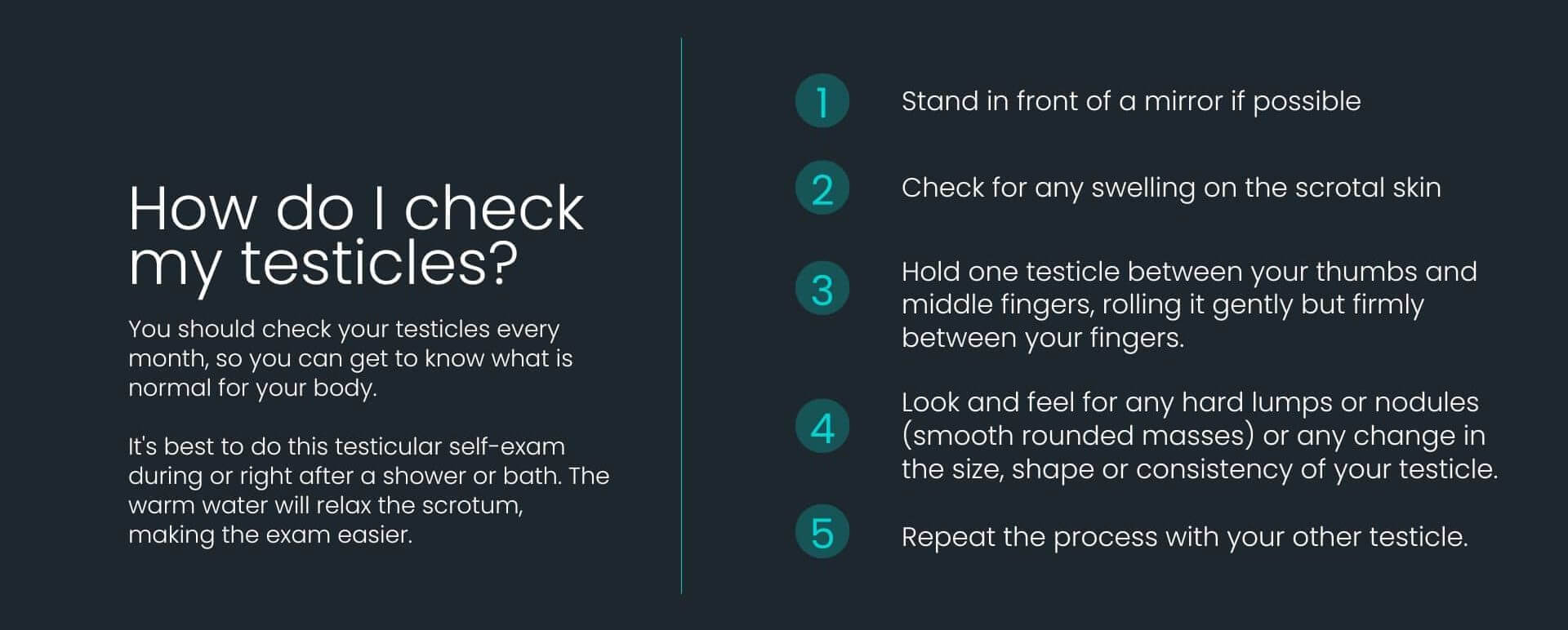Testicular cancer is a serious condition but it has a good prognosis and can be cured in over 95% of cases, especially if caught early on… that’s why regular self-examination is important! In fact, most testicular cancers are found by men themselves or their partners – very few cases are found by a doctor.
Testicular self-exams are important to notice any changes in one’s testicles. By doing monthly self-exams, you should become familiar with your testicles, making it easier to notice any changes.
Symptoms of Testicular Cancer
While most of these symptoms can be caused by testicular cancer, they can also be caused by other conditions. Therefore, it’s a good idea to get them checked out. The most common symptoms of testicular cancer include:
- A lump or swelling in a testicle (not painful)
- Pain in a testicle or scrotum
- An enlarged testicle
- A heavy feeling in the scrotum
- A dull ache in the lower belly or groin
- Sudden swelling in the scrotum

How Do I Check My Testicles?
As mentioned above, you should check your testicles every month so you can get to know what is normal for your body. It’s best to do this testicular self-exam during or right after a shower or bath. The warm water will relax the scrotum, making the exam easier. It’s simple to do, it only takes a couple of minutes…and it could save your life!
You should check your testicles one at a time and standing in front of a mirror can help. You shouldn’t feel any pain when performing the self-exam so be aware of any dull soreness or heaviness. Contrary to what many may assume, cancerous tumours are not usually painful.
Look and feel for any lumps, bumps or unusual features – this is where regular self-examination comes in. The more you do it, the easier it will be to recognise something out of the ordinary. You should also take note of any changes in size over time – while the most common symptom of testicular cancer is a painless mass, some men experience swelling of the testicles and scrotum.
If you notice an abnormal lump, swelling or changes in size or consistency you should speak to your GP straight away. Remember, testicular cancer is highly treatable especially if caught early.
Don’t be alarmed if one testicle seems slightly larger than the other or if it hangs lower than the other – this is normal. Likewise, you should note that each testicle has a soft tube called the epididymis. This may feel like a small bump on the middle or upper outside of the testes. This is normal too, so don’t panic if you feel it! However, if you have any concerns, we recommend speaking to your GP to set your mind at ease.

Is Testicular Cancer Preventable?
No, but there are certain risk factors that may increase your chances of getting the disease. These include the following:
- If you’ve had testicular cancer in the past
- An undescended testicle
- A family member, such as your brother or father, had it
- Fertility issues
- Klinefelter´s syndrome (a rare sex chromosome disorder)
What Treatment Options Are There?
There are two types of testicular cancer – seminoma or non-seminoma. The below treatments are used to treat both.
- Surgery to remove the tumour
- Radiotherapy to destroy cancer cells
- Chemotherapy to cure or control your cancer
Remember, testicular cancer is highly treatable, and the earlier it’s detected, the earlier you can begin treating it. You can visit the Irish Cancer Society’s website for more information on testicular cancer. Alternatively, if you would like to speak with a GP, you can make an appointment via our online video consultation service.
Stay up to date with insightful health & wellness content, as well as new services and offers from Webdoctor.ie, by joining our online community. Find us on Facebook, Instagram & Twitter!









